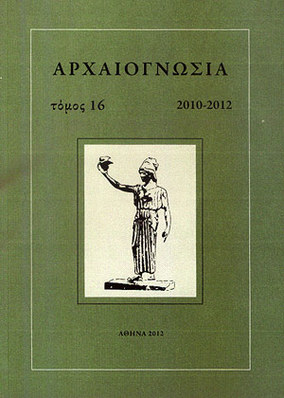Τα εικονογραφικά πρότυπα του γλυπτού διάκοσμου της Ακαδημίας Αθηνών
Part of : Αρχαιογνωσία ; Vol.11, No.1-2, 2001, pages 219-232
Issue:
Pages:
219-232
Parallel Title:
Iconographical prototypes of the Athens Academy's sculptural decoration
Section Title:
Σύμμεικτα
Author:
Abstract:
The sculptural decoration of the neoclassical Sinaia Academy in Athens (PI.21, 23, 25) has not been studied satisfactorily up to now. First of all we ignore who was mainly responsible for the iconographical programme: either Th. Hansen, the architect of the Academy, or L. Drossis, the sculptor, or even Hansens collaborator, the painter Karl Rahl, though a drawing by Hansen, now in the Academy of Arts in Vienna (PI. 2 lß), plausibly suggests that he was the creator. Only the subject of the central pediment of the building (PL 21a) has been recognized with certainty as the «Birth of Athena», and its iconographical affinity to the east pediment of the Parthenon, where the same subject is depicted. Nevertheless the detailed comparison of the figures represented on both of these pediments demonstrates that though similarities exist, there are also substantial differences. They mainly concern the group of Apollo and Leto or Artemis, which is placed to the spectator’s left of the central group in the Academy pediment and which was most probably not represented on the east pediment of the Parthenon. A new invention as well is the group of Aphrodite, Eros and Ares, which is represented to the right of the central group of the Academy’s central pediment. Both these groups were most probably chosen in order to emphasize the role of the Academy as the seat of the Sciences and the Arts, to which Apollo as the god of Arts, Aphrodite and Eros symbolizing the perpetual, spiritual love, and the Agon personalized through Ares, were indispensable. Even more, though Helios and Selene are depicted at the corners of this pediment as was the case with the Parthenonian pediment, their horses and quadrigas have been replaced by dolphins, hinting at the place of their appearance or diasappearance, i.e. the sea. On the other hand the central group of the Academy’s pediment has been adopted from 19th century drawings which reconstruct the central figures of the Parthenonian east pediment, most probably from the drawing of M. Nolau in 1835. On top of that the central figure of the seated Zeus is the same but for a few small changes as presented in the drawing, copying the Roman type of Jupiter Maximus Capitolinus, whose head is a copy of the Zeus Otricoli dated to the 4th c. B.C. or in the Hellenistic period.Furthermore, the free sculptures which are placed in front of the building, i.e. Athena and Apollo (PI. 25a and β), erected on high columns to the left and right of the main entrance of the Academy, as well as the statues of the seated Socrates and Plato (PI. 25y and δ) to the left and the right of the lower staircase, are free adoptions of known ancient sculptural types. For example Apollo is a pasticcio of the Apollo Belvedere type and of other sculptural types of the god; Socrates portrait is copied from a Lysippan portrait of the philosopher of the 4th c. B.C., while for Plato’s head, -in addition to an ancient statue of this philosopher copied for the body—, a Hellenistic portrait of Homer seems to have been in mind. The same is also true for the central akroterion of the Academy’s pediment, which imitates the Aeginetan akroterion of the Aphaia temple replacing the korai statues with winged human figures. The reconstructed Aeginetan akroterion was exhibited in the Glyptothek in Munich at the time, when the Greek Academy was under construction, and was therefore easy to be copied. The question whether the creator of the other iconographical types decorating the Athenian Academy had seen with his own eyes the ancient statues or just their Roman copies, or whether he was inspired through other intermediate sources, for example through European neoclassical works imitating them, has yet to be investigated.
Subject:
Subject (LC):
Keywords:
γλυπτική




